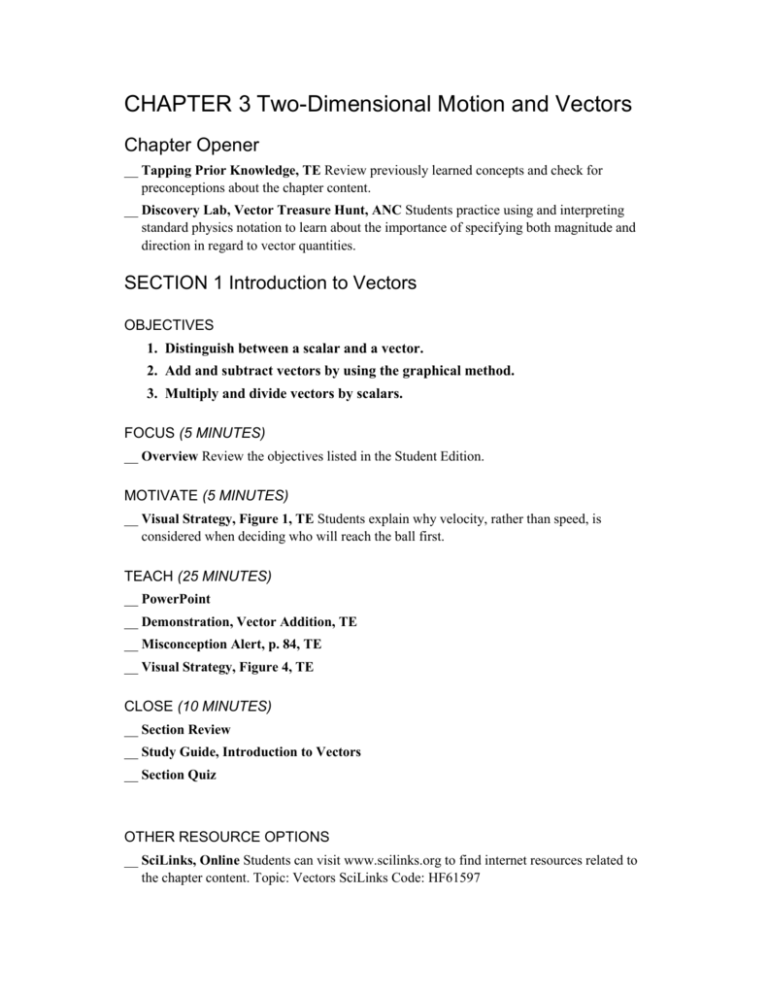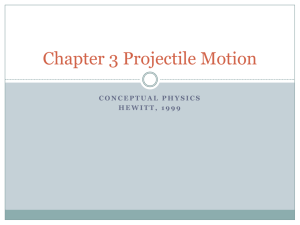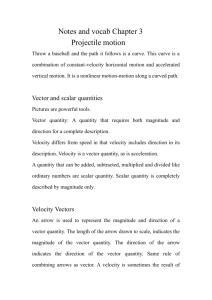CHAPTER 3 Two-Dimensional Motion and Vectors
advertisement

CHAPTER 3 Two-Dimensional Motion and Vectors Chapter Opener __ Tapping Prior Knowledge, TE Review previously learned concepts and check for preconceptions about the chapter content. __ Discovery Lab, Vector Treasure Hunt, ANC Students practice using and interpreting standard physics notation to learn about the importance of specifying both magnitude and direction in regard to vector quantities. SECTION 1 Introduction to Vectors OBJECTIVES 1. Distinguish between a scalar and a vector. 2. Add and subtract vectors by using the graphical method. 3. Multiply and divide vectors by scalars. FOCUS (5 MINUTES) __ Overview Review the objectives listed in the Student Edition. MOTIVATE (5 MINUTES) __ Visual Strategy, Figure 1, TE Students explain why velocity, rather than speed, is considered when deciding who will reach the ball first. TEACH (25 MINUTES) __ PowerPoint __ Demonstration, Vector Addition, TE __ Misconception Alert, p. 84, TE __ Visual Strategy, Figure 4, TE CLOSE (10 MINUTES) __ Section Review __ Study Guide, Introduction to Vectors __ Section Quiz OTHER RESOURCE OPTIONS __ SciLinks, Online Students can visit www.scilinks.org to find internet resources related to the chapter content. Topic: Vectors SciLinks Code: HF61597 SECTION 2 Vector Operations OBJECTIVES 1. Identify appropriate coordinate systems for solving problems with vectors. 2. Apply the Pythagorean Theorem and tangent function to calculate the magnitude and direction of a resultant vector. 3. Resolve vectors into components using the sine and cosine functions. 4. Add vectors that are not perpendicular. FOCUS (5 MINUTES) __ Overview Review the objectives listed in the Student Edition. MOTIVATE (5 MINUTES) __ Visual Strategy, Figure 6, TE TEACH (25 MINUTES) __ PowerPoint __ Sample Set A, Finding Resultant Magnitude __ Classroom Practice, Finding Resultant Magnitude __ Misconception Alert, p. 90, TE Use examples to emphasize that the x component of a vector is not always calculated using the cosine function. __ Sample Set B, Resolving Vectors __ Classroom Practice, Resolving Vectors __ p. 92, TE Help students distinguish between the different vector components in the figure by having them draw each vector and its components separately. __ Sample Set C, Adding Vectors Algebraically __ Classroom Practice, Adding Vectors Algebraically CLOSE (10 MINUTES) __ Section Review __ Study Guide, Vector Coordinates __ Section Quiz OTHER RESOURCE OPTIONS __ Problem Workbook, Sample Set A: Finding Resultant Magnitude __ Problem Bank, Sample Set A: Finding Resultant Magnitude __ Problem Workbook, Sample Set B: Resolving Vectors __ Problem Bank, Sample Set B: Resolving Vectors __ Problem Workbook, Sample Set C: Adding Vectors Algebraically __ Problem Bank, Sample Set C: Adding Vectors Algebraically SECTION 3 Projectile Motion OBJECTIVES 1. Recognize examples of projectile motion. 2. Describe the path of a projectile as a parabola. 3. Resolve vectors into their components and apply the kinematic equations to solve problems involving projectile motion. FOCUS (5 MINUTES) __ Overview Review the objectives listed in the Student Edition. MOTIVATE (5 MINUTES) __ Visual Strategy, Figure 13, TE Students discuss whether the angle of takeoff matters to the jumper in the photo. TEACH (115 MINUTES) __ PowerPoint __ Demonstration, Air Resistance, TE __ Quick Lab, Two-Dimensional Motion, SE __ Datasheet, Projectile Motion Students use the datasheet to complete the in-text QuickLab __ Demonstration, Two-Dimensional Motion, TE __ Sample Set D, Projectiles Launched Horizontally, SE __ Classroom Practice, Projectiles Launched Horizontally, TE __ Visual Strategy, Figure 17, TE Emphasize to students that a projectile follows a parabolic path from the time it is fired. __ Sample Set E, Projectiles Launched at an Angle __ Classroom Practice, Projectiles Launched at an Angle __ Inquiry Lab, Velocity of a Projectile, SE Students measure the velocity of projectiles in terms of their horizontal displacement during free fall. ( __ Datasheet, Velocity of a Projectile, ANC Students use the datasheet to complete the in text lab CLOSE (10 MINUTES) __ Section Review __ Study Guide, Projectile Motion __ Section Quiz OTHER RESOURCE OPTIONS __ Problem Workbook, Sample Set D: Projectiles Launched Horizontally __ Problem Bank, Sample Set D: Projectiles Launched Horizontally __ Problem Workbook, Sample Set E: Projectiles Launched at an Angle __ Problem Bank, Sample Set E: Projectiles Launched at an Angle __ Datasheet, Velocity of a Projectile __ Invention Lab, The Path of a Human Cannonball Students use a model and projectile motion calculations to recommend the placement of both a flaming hoop and a net for use in a human cannonball act. (ADVANCED STUDENTS) __ CBLTM Experiment, Projectile Motion, ANC In this scenario-based CBL lab, students use CBLs and sensors to develop a model to find the velocity for a stunt car in a movie scene to have the desired horizontal displacement when it is driven off a cliff. (ADVANCED STUDENTS) __ SciLinks, Online Students can visit www.scilinks.org to find internet resources related to the chapter content. Topic: Projectile Motion SciLinks Code: HF61223 SECTION 4 Relative Motion OBJECTIVES 1. Describe situations in terms of frame of reference. 2. Solve problems involving relative velocity. FOCUS (5 MINUTES) __ Overview Review the objectives listed in the Student Edition. MOTIVATE (5 MINUTES) __ Visual Strategy, Figure 19, TE Students explain how the two diagrams would change if air resistance were included. TEACH (25 MINUTES) __ PowerPoint __ Appendix J: Advanced Topics, Special Relativity and Velocities, SE This feature allows students to explore higher-level concepts related to the chapter. (ADVANCED STUDENTS) __ Conceptual Challenge, p. 103, SE These conceptual questions challenge students to apply the section content to real-world applications. (ADVANCED STUDENTS) __ Sample Set F, Relative Velocity __ Classroom Practice, Relative Velocity CLOSE (10 MINUTES) __ Section Review __ Study Guide, Relative Motion __ Section Quiz OTHER RESOURCE OPTIONS __ Problem Workbook, Sample Set F: Relative Velocity __ Problem Bank, Sample Set F: Relative Velocity END OF CHAPTER REVIEW AND ASSESSMENT (45 minutes) __ pp. 108–113, SE Students review the chapter material with review questions, conceptual questions, practice problems, and a mixed review section. __ p. 113, SE These projects challenge students to apply and extend concepts that they have learned in the chapter. (ADVANCED STUDENTS) __ Graphing Calculator Practice, p. 113, SE Students use their graphing calculators to create a graph of height versus time so that they can predict how high a vertically thrown baseball will go and how long it will remain in flight. __ Standardized Test Prep, pp. 114–115 __ Appendix D: Equations, pp. 854–855 __ Appendix I: Additional Problems, pp. 881-882 __ Study Guide, Mixed Review __ Chapter Test A






